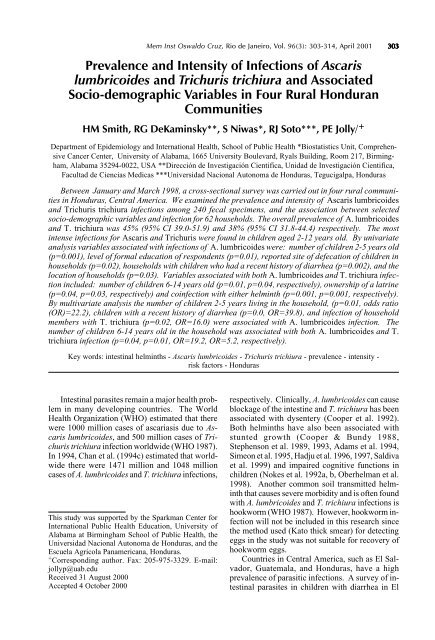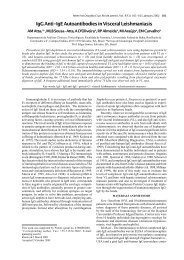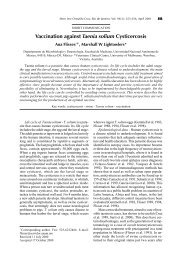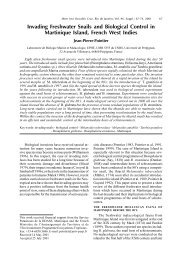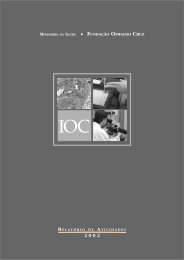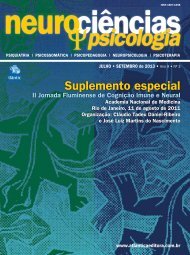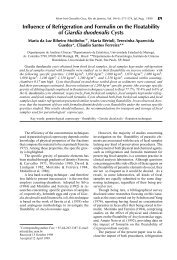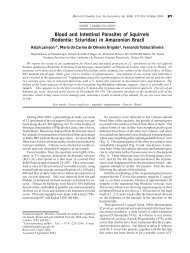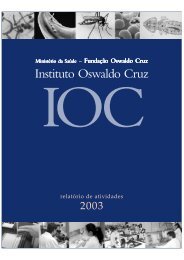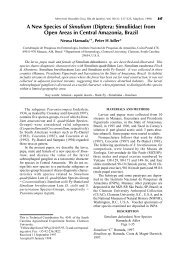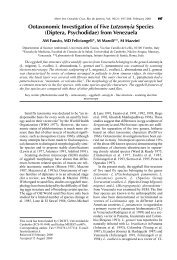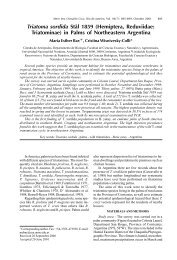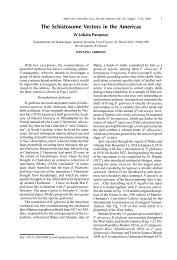Prevalence and Intensity of Infections of Ascaris ... - SciELO
Prevalence and Intensity of Infections of Ascaris ... - SciELO
Prevalence and Intensity of Infections of Ascaris ... - SciELO
You also want an ePaper? Increase the reach of your titles
YUMPU automatically turns print PDFs into web optimized ePapers that Google loves.
Mem Inst Oswaldo Cruz, Rio de Janeiro, Vol. 96(3): 303-314, April 2001<br />
<strong>Prevalence</strong> <strong>and</strong> <strong>Intensity</strong> <strong>of</strong> <strong>Infections</strong> <strong>of</strong> <strong>Ascaris</strong><br />
lumbricoides <strong>and</strong> Trichuris trichiura <strong>and</strong> Associated<br />
Socio-demographic Variables in Four Rural Honduran<br />
Communities<br />
HM Smith, RG DeKaminsky**, S Niwas*, RJ Soto***, PE Jolly/ +<br />
303<br />
Department <strong>of</strong> Epidemiology <strong>and</strong> International Health, School <strong>of</strong> Public Health *Biostatistics Unit, Comprehensive<br />
Cancer Center, University <strong>of</strong> Alabama, 1665 University Boulevard, Ryals Building, Room 217, Birmingham,<br />
Alabama 35294-0022, USA **Dirección de Investigación Cientifica, Unidad de Investigación Cientifica,<br />
Facultad de Ciencias Medicas ***Universidad Nacional Autonoma de Honduras, Tegucigalpa, Honduras<br />
Between January <strong>and</strong> March 1998, a cross-sectional survey was carried out in four rural communities<br />
in Honduras, Central America. We examined the prevalence <strong>and</strong> intensity <strong>of</strong> <strong>Ascaris</strong> lumbricoides<br />
<strong>and</strong> Trichuris trichiura infections among 240 fecal specimens, <strong>and</strong> the association between selected<br />
socio-demographic variables <strong>and</strong> infection for 62 households. The overall prevalence <strong>of</strong> A. lumbricoides<br />
<strong>and</strong> T. trichiura was 45% (95% CI 39.0-51.9) <strong>and</strong> 38% (95% CI 31.8-44.4) respectively. The most<br />
intense infections for <strong>Ascaris</strong> <strong>and</strong> Trichuris were found in children aged 2-12 years old. By univariate<br />
analysis variables associated with infections <strong>of</strong> A. lumbricoides were: number <strong>of</strong> children 2-5 years old<br />
(p=0.001), level <strong>of</strong> formal education <strong>of</strong> respondents (p=0.01), reported site <strong>of</strong> defecation <strong>of</strong> children in<br />
households (p=0.02), households with children who had a recent history <strong>of</strong> diarrhea (p=0.002), <strong>and</strong> the<br />
location <strong>of</strong> households (p=0.03). Variables associated with both A. lumbricoides <strong>and</strong> T. trichiura infection<br />
included: number <strong>of</strong> children 6-14 years old (p=0.01, p=0.04, respectively), ownership <strong>of</strong> a latrine<br />
(p=0.04, p=0.03, respectively) <strong>and</strong> coinfection with either helminth (p=0.001, p=0.001, respectively).<br />
By multivariate analysis the number <strong>of</strong> children 2-5 years living in the household, (p=0.01, odds ratio<br />
(OR)=22.2), children with a recent history <strong>of</strong> diarrhea (p=0.0, OR=39.8), <strong>and</strong> infection <strong>of</strong> household<br />
members with T. trichiura (p=0.02, OR=16.0) were associated with A. lumbricoides infection. The<br />
number <strong>of</strong> children 6-14 years old in the household was associated with both A. lumbricoides <strong>and</strong> T.<br />
trichiura infection (p=0.04, p=0.01, OR=19.2, OR=5.2, respectively).<br />
Key words: intestinal helminths - <strong>Ascaris</strong> lumbricoides - Trichuris trichiura - prevalence - intensity -<br />
risk factors - Honduras<br />
Intestinal parasites remain a major health problem<br />
in many developing countries. The World<br />
Health Organization (WHO) estimated that there<br />
were 1000 million cases <strong>of</strong> ascariasis due to <strong>Ascaris</strong><br />
lumbricoides, <strong>and</strong> 500 million cases <strong>of</strong> Trichuris<br />
trichiura infection worldwide (WHO 1987).<br />
In 1994, Chan et al. (1994c) estimated that worldwide<br />
there were 1471 million <strong>and</strong> 1048 million<br />
cases <strong>of</strong> A. lumbricoides <strong>and</strong> T. trichiura infections,<br />
This study was supported by the Sparkman Center for<br />
International Public Health Education, University <strong>of</strong><br />
Alabama at Birmingham School <strong>of</strong> Public Health, the<br />
Universidad Nacional Autonoma de Honduras, <strong>and</strong> the<br />
Escuela Agricola Panamericana, Honduras.<br />
+ Corresponding author. Fax: 205-975-3329. E-mail:<br />
jollyp@uab.edu<br />
Received 31 August 2000<br />
Accepted 4 October 2000<br />
respectively. Clinically, A. lumbricoides can cause<br />
blockage <strong>of</strong> the intestine <strong>and</strong> T. trichiura has been<br />
associated with dysentery (Cooper et al. 1992).<br />
Both helminths have also been associated with<br />
stunted growth (Cooper & Bundy 1988,<br />
Stephenson et al. 1989, 1993, Adams et al. 1994,<br />
Simeon et al. 1995, Hadju et al. 1996, 1997, Saldiva<br />
et al. 1999) <strong>and</strong> impaired cognitive functions in<br />
children (Nokes et al. 1992a, b, Oberhelman et al.<br />
1998). Another common soil transmitted helminth<br />
that causes severe morbidity <strong>and</strong> is <strong>of</strong>ten found<br />
with A. lumbricoides <strong>and</strong> T. trichiura infections is<br />
hookworm (WHO 1987). However, hookworm infection<br />
will not be included in this research since<br />
the method used (Kato thick smear) for detecting<br />
eggs in the study was not suitable for recovery <strong>of</strong><br />
hookworm eggs.<br />
Countries in Central America, such as El Salvador,<br />
Guatemala, <strong>and</strong> Honduras, have a high<br />
prevalence <strong>of</strong> parasitic infections. A survey <strong>of</strong> intestinal<br />
parasites in children with diarrhea in El
304 Intestinal Helminth <strong>Infections</strong> in Rural Honduras • HM Smith et al.<br />
Salvador, demonstrated that 18% <strong>of</strong> the children<br />
were infected with A. lumbricoides <strong>and</strong> 31% with<br />
T. trichiura (Reinthaler et al. 1988). In Guatemala,<br />
41% <strong>of</strong> the population in a rural village was infected<br />
with A. lumbricoides <strong>and</strong> 60% with T.<br />
trichiura (Anderson et al. 1993). Data from 14<br />
public health laboratories in Honduras for 1991<br />
showed A. lumbricoides infections in people <strong>of</strong> all<br />
ages ranging from 70% in Tocoa at the northern<br />
coast to 5% in Nacaome, near the Pacific coast.<br />
Percentages <strong>of</strong> individuals infected with T.<br />
trichiura were lower, ranging from 32% to 1% in<br />
the above mentioned areas (Kaminsky 1996a).<br />
Although many studies regarding intestinal<br />
parasites focus on establishing the prevalence <strong>and</strong><br />
intensity <strong>of</strong> these infections in different populations,<br />
fewer studies have examined the socio-cultural<br />
factors that affect transmission <strong>of</strong> intestinal<br />
helminths. Some studies have shown that the lack<br />
<strong>of</strong> education, lack <strong>of</strong> latrines, occurrence <strong>of</strong> diarrhea,<br />
lower socio-economic status, inadequate disposal<br />
<strong>of</strong> human excreta <strong>and</strong> the level <strong>of</strong> sanitation<br />
in households are related to parasitoses (Cooper &<br />
Bundy 1988, Holl<strong>and</strong> et al. 1988, Yasuf & Hussain<br />
1990, Rajeswari et al. 1994, Tshikuka et al. 1995,<br />
Ighogboja et al. 1997, Mahfouz et al. 1997,<br />
Pegelow et al. 1997, Gamboa et al. 1998). These<br />
reports coupled with the fact that there have been<br />
few surveys designed to determine associations<br />
between socio-cultural variables <strong>and</strong> intestinal helminth<br />
prevalence data prompted us to initiate this<br />
study in four rural Honduran communities.<br />
In this study, we collaborated with Project<br />
UNIR (unite) based at the Panamerican Agricultural<br />
School (Escuela Agricola Panamericana-<br />
EAP), El Zamorano. The School is located in the<br />
Zamorano Valley, 40 km from Tegucigalpa, the<br />
nation’s capital <strong>and</strong> was very willing <strong>and</strong> helpful<br />
in providing the necessary facilities <strong>and</strong> accommodations<br />
for one <strong>of</strong> us (HMS). Project UNIR is<br />
an organization at the EAP that was established in<br />
1996. Its principal goals are both rural development<br />
<strong>and</strong> l<strong>and</strong> conservation. We studied the prevalence<br />
<strong>and</strong> intensity <strong>of</strong> <strong>Ascaris</strong> <strong>and</strong> Trichuris infections<br />
in individuals <strong>of</strong> all ages in four communities<br />
under UNIR, <strong>and</strong> identified variables that have<br />
an important association with such infections.<br />
MATERIALS AND METHODS<br />
Study area <strong>and</strong> population - A cross-sectional<br />
survey was conducted between January <strong>and</strong> March<br />
1998, in four rural communities in Honduras: El<br />
Llano, El Chaguite, Santa Ines, <strong>and</strong> El Chaguite-<br />
Belen. These communities were selected because<br />
they were part <strong>of</strong> an on-going nutritional study<br />
being conducted by students <strong>and</strong> staff under UNIR<br />
at the EAP <strong>and</strong> were accessible. El Llano, El<br />
Chaguite, <strong>and</strong> Santa Ines are located in the municipality<br />
<strong>of</strong> San Antonio de Oriente. El Chaguite-<br />
Belen lies in the municipality <strong>of</strong> Maraita. These<br />
municipalities form part <strong>of</strong> the department <strong>of</strong> Francisco<br />
Morazan (Fig. 1). The estimated populations<br />
<strong>of</strong> El Llano, El Chaguite, Santa Ines <strong>and</strong> El<br />
Chaguite-Belen were 261, 437, 237 <strong>and</strong> 225 respectively.<br />
The four communities are located 40-<br />
60 km from Tegucigalpa, the nation’s capital. The<br />
majority <strong>of</strong> the inhabitants were subsistence farmers<br />
<strong>and</strong> had limited access to major cities.<br />
Collection <strong>of</strong> data - Approval for this study was<br />
obtained from the Institutional Review Board at<br />
the University <strong>of</strong> Alabama at Birmingham, <strong>and</strong><br />
local institutions in Honduras. The EAP provided<br />
facilities, laboratory space <strong>and</strong> equipment. Prior<br />
to the beginning <strong>of</strong> the study, community meetings<br />
were held in public schools in the four communities.<br />
The study was discussed with the community<br />
members who were informed that their<br />
participation was voluntary. A pilot questionnaire<br />
was subsequently administered to two individuals<br />
from two separate households in Santa Ines <strong>and</strong> El<br />
Chaguite-Belen, respectively. Maps <strong>of</strong> each community<br />
were obtained from UNIR <strong>of</strong>fice files.<br />
Names <strong>of</strong> the heads-<strong>of</strong>-households were obtained<br />
from community members. Households to be visited<br />
were r<strong>and</strong>omly selected using the listed names<br />
<strong>of</strong> the head-<strong>of</strong>-household. It is noteworthy that<br />
“household” may have been comprised <strong>of</strong> more<br />
than one dwelling unit. The criteria for participation<br />
were that participants were related to the head<strong>of</strong>-household,<br />
<strong>and</strong>/or considered themselves as<br />
members <strong>of</strong> the household. The entire household,<br />
except children less than 2 years old, was included<br />
in the study. Excluded from the study were individuals<br />
who did not live fulltime in the community<br />
being surveyed <strong>and</strong> households where individuals<br />
had completed the pilot questionnaire. The<br />
latter were excluded in order to minimize bias.<br />
Personal interviews were conducted after obtaining<br />
the informed verbal consent <strong>of</strong> the caretaker.<br />
A pre-tested, st<strong>and</strong>ardized questionnaire<br />
was used to obtain information, such as, the number<br />
<strong>and</strong> ages <strong>of</strong> children in the household, level<br />
<strong>of</strong> education, sex, age <strong>of</strong> caretaker, whether someone<br />
in the household had passed A. lumbricoides,<br />
knowledge <strong>of</strong> how one acquires <strong>Ascaris</strong>, whether<br />
the household had a latrine, where the respondent<br />
<strong>and</strong> the children in the household defecated,<br />
whether the respondent <strong>and</strong> the children in the<br />
household used the latrine regularly, why not (if<br />
applicable), whether children in the household had<br />
had diarrhea recently, <strong>and</strong> how the respondent<br />
thought children acquired “worms”. A preserved<br />
specimen <strong>of</strong> A. lumbricoides was used for demonstration<br />
purposes. A total <strong>of</strong> 62 caretakers, 14
Mem Inst Oswaldo Cruz, Rio de Janeiro, Vol. 96(3), April 2001<br />
305<br />
Fig. 1: map showing location <strong>of</strong> El Chaguite, El Chaguite-Belen, El Llano <strong>and</strong> Santa Ines, Department <strong>of</strong> Francisco Morazan,<br />
Honduras.<br />
from El Chaguite, 14 from El Chaguite-Belen, 18<br />
from El Llano <strong>and</strong> 16 from Santa Ines, were interviewed.<br />
Collection <strong>and</strong> analysis <strong>of</strong> fecal specimens -<br />
Following the questionnaire, specimen cups labeled<br />
with name, age, <strong>and</strong> gender were given to each<br />
individual in the household who wanted to participate<br />
in the study. The next morning the specimens<br />
were retrieved <strong>and</strong> taken to a laboratory at the EAP<br />
for analysis. Only one specimen was submitted<br />
per individual. A total <strong>of</strong> 240 specimens were collected<br />
from the four sites; 66 from El Chaguite, 44<br />
from El Chaguite-Belen, 74 from El Llano, <strong>and</strong> 56<br />
from Santa Ines. The Kato-Katz thick smear st<strong>and</strong>ardized<br />
to deliver 41.7 mg <strong>of</strong> strained stool was<br />
used to diagnose A. lumbricoides <strong>and</strong> T. trichiura<br />
infections <strong>and</strong> estimate their intensity through egg<br />
counts (Kaminsky 1996b). Individuals were categorized<br />
as having light, moderate or heavy infections<br />
based on criteria set by WHO (1987). For A.<br />
lumbricoides an egg count <strong>of</strong> 0-4,999 eggs per<br />
gram (epg) <strong>of</strong> feces is regarded as a light infection<br />
<strong>and</strong> 5,000-50,000 epg, <strong>and</strong> >50,000 epg as moderate<br />
<strong>and</strong> heavy infections respectively. In T.<br />
trichiura infection the presence <strong>of</strong> 0-999 epg is<br />
regarded as a light infection, between 1,000-10,000<br />
epg as a moderate infection <strong>and</strong> >10,000 epg as a<br />
heavy infection (WHO 1987).<br />
Data analyses - Epi Info Version 6.0 s<strong>of</strong>tware<br />
(CDC, Atlanta, GA) <strong>and</strong> SAS s<strong>of</strong>tware (SAS Institute,<br />
Cary, NC) were used to analyze frequency,<br />
prevalence, intensity <strong>and</strong> associations. Socio-de-
306 Intestinal Helminth <strong>Infections</strong> in Rural Honduras • HM Smith et al.<br />
mographic variables were categorized into two<br />
or three groups. The chi-square or Fisher’s exact<br />
test was calculated using the SAS s<strong>of</strong>tware to assess<br />
the univariate association <strong>of</strong> the variables<br />
with the presence <strong>of</strong> A. lumbricoides <strong>and</strong> T.<br />
trichiura in each household. A multiple logistic<br />
regression model, using the SAS s<strong>of</strong>tware, was<br />
employed to determine variables significantly associated<br />
with <strong>Ascaris</strong> infection. Only variables<br />
that were significantly associated with A.<br />
lumbricoides from the univariate model were included<br />
in the multiple logistic regression model.<br />
A stepwise selection method was employed to determine<br />
the variables significantly associated with<br />
A. lumbricoides infection. The fit <strong>of</strong> the final logistic<br />
regression model was assessed using the log<br />
likelihood ratio test <strong>and</strong> Akaike information criterion<br />
(AIC). Odds ratios <strong>and</strong> the corresponding st<strong>and</strong>ard<br />
errors were calculated using the variables significantly<br />
associated with A. lumbricoides infection.<br />
A similar analytical approach was performed<br />
to determine those variables significantly associated<br />
with T. trichiura infection.<br />
RESULTS<br />
Description <strong>of</strong> the study population - The mean<br />
age <strong>of</strong> respondents to the questionnaire was 39.4<br />
years [st<strong>and</strong>ard deviation (SD)=16.3, median<br />
age=35.5 years] <strong>and</strong> more than 95% <strong>of</strong> respondents<br />
were females. The age <strong>of</strong> the 240 subjects sampled<br />
ranged from 2 to 84 years with a mean age <strong>of</strong> 20.6<br />
years (SD=19.3, median age=11.0). Fifty-three<br />
percent <strong>of</strong> those sampled were female <strong>and</strong> 47%<br />
male. Seventy-one percent <strong>of</strong> respondents had<br />
some formal education; the majority (51.6%) had<br />
some primary education (completed 1-6 years) <strong>and</strong><br />
19.4% had some years <strong>of</strong> secondary education<br />
(completed 7-12 years).<br />
<strong>Prevalence</strong> <strong>and</strong> intensity <strong>of</strong> A. lumbricoides <strong>and</strong><br />
T. trichiura - The overall prevalence <strong>of</strong> A.<br />
lumbricoides <strong>and</strong> T. trichiura in these four communities<br />
was 45% (95% CI 39.0-51.9) <strong>and</strong> 38%<br />
(95% CI 31.8-44.4), respectively (Table I). Over<br />
a quarter (25.8%) <strong>of</strong> the 240 stool specimens examined<br />
had double infection <strong>of</strong> both A.<br />
lumbricoides <strong>and</strong> T. trichiura. Table I shows the<br />
differences in prevalence <strong>and</strong> intensity <strong>of</strong> <strong>Ascaris</strong><br />
<strong>and</strong> Trichuris infection by age group <strong>and</strong> community.<br />
Overall, infections <strong>of</strong> <strong>Ascaris</strong> were mostly<br />
moderate <strong>and</strong> light, except in El Chaguite where<br />
there were heavy infections. There were primarily<br />
light infections <strong>of</strong> T. trichiura, except again in El<br />
Chaguite where moderate infections were observed.<br />
There were no heavy infections <strong>of</strong> T.<br />
trichiura.<br />
El Llano had the lowest prevalence overall <strong>of</strong><br />
both A. lumbricoides <strong>and</strong> T. trichiura <strong>and</strong> the least<br />
number <strong>of</strong> T. trichiura infections across all age<br />
groups. Twenty-two percent <strong>of</strong> the population surveyed<br />
in this community was infected with <strong>Ascaris</strong><br />
<strong>and</strong> 11% were infected with Trichuris. Most infections,<br />
including one case <strong>of</strong> heavy infection <strong>and</strong><br />
two cases <strong>of</strong> moderate infection with <strong>Ascaris</strong>, were<br />
found in children 2-4 years old <strong>and</strong> 5-12 years old.<br />
However, there were no infections <strong>of</strong> Trichuris in<br />
the 2-4 age group.<br />
El Chaguite was the community with the highest<br />
prevalence <strong>of</strong> <strong>Ascaris</strong> <strong>and</strong> Trichuris; 82% <strong>of</strong><br />
those surveyed had infections <strong>of</strong> <strong>Ascaris</strong> <strong>and</strong> 71%<br />
had infections <strong>of</strong> Trichuris. El Chaguite had much<br />
higher rates <strong>of</strong> infection in all age groups with A.<br />
lumbricoides <strong>and</strong> T. trichiura. Most infections <strong>of</strong><br />
T. trichiura occurred in those 5-12 years old followed<br />
by individuals >12 years old.<br />
The prevalence <strong>of</strong> <strong>Ascaris</strong> in Santa Ines <strong>and</strong> El<br />
Chaguite-Belen was 29% <strong>and</strong> 52%, respectively.<br />
The prevalence <strong>of</strong> Trichuris in each <strong>of</strong> these communities<br />
was 30% <strong>and</strong> 43%, respectively. In Santa<br />
Ines, individuals aged 2-4, had the highest frequency<br />
(40%) <strong>of</strong> moderate <strong>Ascaris</strong> infection, while<br />
those aged 5-12 <strong>and</strong> >12 had substantial frequencies<br />
(close to 30%) <strong>of</strong> both moderate <strong>and</strong> light infections.<br />
Individuals aged 5-12 years had the highest<br />
frequency (48%) <strong>of</strong> light infections <strong>of</strong> T.<br />
trichiura. Twenty percent <strong>of</strong> those >12 years old<br />
had light infections <strong>of</strong> Trichuris. In El Chaguite-<br />
Belen the highest frequency <strong>of</strong> infection (moderate<br />
<strong>and</strong> light) <strong>of</strong> <strong>Ascaris</strong> <strong>and</strong> Trichuris occurred in<br />
those aged 5-12, followed by those aged >12.<br />
There was only one infection <strong>of</strong> <strong>Ascaris</strong> or Trichuris<br />
in children aged 2-4 in this community<br />
(Table I).<br />
Fig. 2 shows the overall intensity <strong>of</strong> A.<br />
lumbricoides infections in all the communities.<br />
Children aged 2-4 had the heaviest infections<br />
while children aged 5 to 12 were most frequently<br />
infected with moderate <strong>and</strong> light infections compared<br />
to other age groups. Overall, there were<br />
more intense infections (heavy <strong>and</strong>/or moderate)<br />
<strong>of</strong> <strong>Ascaris</strong> than Trichuris in all age groups. Fig.<br />
3 shows the overall intensity <strong>of</strong> T. trichiura infections<br />
in all the communities. Children aged 5<br />
to 12 more frequently had moderate <strong>and</strong> light infections<br />
<strong>of</strong> Trichuris compared to other age<br />
groups. There were more light infections <strong>of</strong> Trichuris<br />
in children aged 5 to 12 than there were<br />
light infections <strong>of</strong> <strong>Ascaris</strong> in the same age group.<br />
Also, individuals >12 years were more frequently<br />
infected with light infections <strong>of</strong> Trichuris than<br />
they were with light infections <strong>of</strong> <strong>Ascaris</strong>.<br />
Socio-demographic characteristics <strong>of</strong> household<br />
by infections <strong>of</strong> A. lumbricoides <strong>and</strong> T.<br />
trichiura - Univariate analysis was used to exam-
Mem Inst Oswaldo Cruz, Rio de Janeiro, Vol. 96(3), April 2001<br />
307<br />
TABLE I<br />
<strong>Intensity</strong> <strong>of</strong> <strong>Ascaris</strong> lumbricoides <strong>and</strong> Trichuris trichiura by age in four rural Honduran communities<br />
A. lumbricoides T. trichiura<br />
Community/ Heavy Moderate Light Total Moderate Light Total<br />
age in years (N) N (%) N (%) N (%) infected N (%) N (%) infected<br />
(%) (%)<br />
El Llano (N = 74)<br />
2-4 (12) 1 (8.3) — 4 (33.3) 5 (42) — — —<br />
5-12 (28) — 2 (7.1) 7 (25.0) 9 (32) — 7 (25.0) 7 (25)<br />
>12 (34) — — 2 (5.9) 2 (5.9) — 1 (2.9) 1 (3)<br />
Total infected (%) 16 (22) 8 (11)<br />
El Chaguite (N = 66)<br />
2-4 (9) 2 (22.2) 4 (44.4) 1 (11.1) 7 (78) — 2 (22.2) 2 (22)<br />
5-12 (28) 8 (28.6) 14 (50.0) 4 (14.3) 26 (93) 6 (21.4) 18 (64.3) 24 (86)<br />
>12 (29) — 10 (34.5) 11 (37.9) 21 (73) 2 (6.9) 19 (65.5) 21 (72)<br />
Total infected (%) 54 (82) 47 (71)<br />
Santa Ines (N = 56)<br />
2-4 (5) — 2 (40.0) — 2 (40) — 1 (20.0) 1 (20)<br />
5-12 (21) — 2 (9.5) 4 (19.0) 6 (29) — 10 (48) 10 (48)<br />
>12 (30) — 3 (10.0) 5 (16.7) 8 (27) — 6 (20) 6 (20)<br />
Total infected (%) 16 (29) 17 (30)<br />
El Chaguite-Belen (N = 44)<br />
2-4 (4) — 1 (25.0) — 1 (25) — 1 (25.0) 1 (25)<br />
5-12 (19) — 7 (36.8) 5 (26.3) 12 (63) 2 (10.5) 9 (47.4) 11 (58)<br />
>12 (21) — 7 (33.3) 3 (14.3) 10 (48) 7 (33.3) 7 (33)<br />
Total infected (%) 23 (52) 19 (43)<br />
All communities (N = 240)<br />
2-4 (30) 3 (10) 7 (23) 5 (17) 15 (50) — 4 (13) 4 (13)<br />
5-12 (96) 8 (8) 25 (26) 20 (21) 53 (55) 8 (8) 44 (46) 52 (54)<br />
>12 (114) — 20 (17.5) 21 (18.4) 41 (35.9) 2 (1.8) 33 (28.9) 35 (30.7)<br />
Total 109 (45) 91 (38)<br />
95% CI 39.0-51.9 31.8-44.4<br />
N: number; —: none infected<br />
% infected<br />
30<br />
25<br />
20<br />
15<br />
10<br />
Heavy infection<br />
Moderate infection<br />
Light infection<br />
% infected<br />
50<br />
45<br />
40<br />
35<br />
30<br />
25<br />
20<br />
15<br />
Moderate infection<br />
Light infection<br />
5<br />
10<br />
0<br />
2-4 5-12 >12<br />
Age group (years)<br />
5<br />
0<br />
2-4 5-12 >12<br />
Age group (years)<br />
Fig. 2: intensity <strong>of</strong> <strong>Ascaris</strong> lumbricoides infection by age group<br />
categories in four rural communities in Honduras<br />
Fig. 3: intensity <strong>of</strong> Trichuris trichuria infection by age group<br />
categories in four rural communities in Honduras
308 Intestinal Helminth <strong>Infections</strong> in Rural Honduras • HM Smith et al.<br />
ine relationships between socio-demographic variables<br />
reported for the households <strong>and</strong> infections<br />
<strong>of</strong> A. lumbricoides <strong>and</strong> T. trichiura. <strong>Infections</strong> <strong>of</strong><br />
A. lumbricoides by household associated with infections<br />
<strong>of</strong> T. trichiura <strong>and</strong> vice versa (p=0.001)<br />
(Tables II, III).<br />
The four communities differed markedly from<br />
each other with respect to the prevalence <strong>of</strong> infections<br />
by both parasites, but only A. lumbricoides<br />
infection was significantly associated with infection<br />
by location <strong>of</strong> the household (p=0.03) (Table<br />
II). A higher percentage <strong>of</strong> households located in<br />
El Chaguite or El Chaguite-Belen, had members<br />
infected with A. lumbricoides than households in<br />
El Llano or Santa Ines. There were significant differences<br />
in prevalence between communities.<br />
When El Chaguite was compared univariately with<br />
the other three communities, in every instance, living<br />
in El Chaguite was significantly associated<br />
(p
Mem Inst Oswaldo Cruz, Rio de Janeiro, Vol. 96(3), April 2001<br />
309<br />
II). Households with children in these age groups<br />
had a greater frequency <strong>of</strong> <strong>Ascaris</strong> infection compared<br />
to households with no children in these age<br />
groups (Table II). Similarly, the number <strong>of</strong> children<br />
6-14 years old in the household was also associated<br />
with infections <strong>of</strong> T. trichiura (p=0.01)<br />
(Table III). Households with children in this age<br />
group had a greater frequency <strong>of</strong> Trichuris infections<br />
than those households with no children in the<br />
age group.<br />
Education was associated with A. lumbricoides<br />
infection within households (p=0.01) (Table II).<br />
A lower proportion (25%) <strong>of</strong> family members was<br />
infected with A. lumbricoides in households where<br />
the respondent had a secondary education than in<br />
households where the respondent had no formal<br />
education (66.7%).<br />
Gender was examined as a possible variable<br />
associated with parasitoses. Approximately 45%<br />
<strong>of</strong> males <strong>and</strong> 45% <strong>of</strong> females <strong>of</strong> all ages surveyed<br />
were infected with A. lumbricoides. Approximately<br />
41% <strong>of</strong> males <strong>and</strong> 35% <strong>of</strong> females <strong>of</strong> all ages were<br />
positive for infections with T. trichiura. There was<br />
no significant difference with respect to gender<br />
regarding infection with either <strong>Ascaris</strong> (p=0.97)<br />
or Trichuris (p=0.35) in the population surveyed.<br />
Also, there was no significant difference between<br />
gender with reference to intensity for <strong>Ascaris</strong><br />
(p=0.64) or Trichuris (p=0.20) infections.<br />
Associations between sanitary practices <strong>and</strong><br />
infections <strong>of</strong> <strong>Ascaris</strong> or Trichuris by household<br />
was also examined. In this respect, certain variables<br />
such as lack <strong>of</strong> a latrine (p=0.04, p=0.03)<br />
(Tables II, III), respondents defecating in a site<br />
other than the latrine (p=0.01, p=0.04) (Tables II,<br />
III), children defecating in a site other than the latrine<br />
(p=0.02) (Table II), <strong>and</strong> children with a recent<br />
history <strong>of</strong> diarrrhea (p=0.002) (Table II) were<br />
associated with infections <strong>of</strong> either A. lumbricoides<br />
or T. trichiura respectively. In each case, households<br />
that did not own a latrine, or households<br />
where respondents <strong>and</strong> children did not always use<br />
the latrine for defecation, or where children were<br />
reported with diarrhea, had a higher percentage <strong>of</strong><br />
members with infections <strong>of</strong> either helminth.<br />
The most common reason given by respondents<br />
who did not always use the latrine for defecation,<br />
was that the family did not own one (31.6%). Other<br />
common reasons given were that the latrine was<br />
broken (26.3%) or that it was too far (21.1%).<br />
Twenty-one percent <strong>of</strong> respondents had reasons<br />
other than those given above. The most common<br />
reasons given by respondents for children not always<br />
using the latrine was that the children did not<br />
know how to use it because they were too young<br />
(30%), that the latrine was too far (20%), <strong>and</strong> that<br />
the household did not own one (20%). Another<br />
16.7% said that the latrine was broken, <strong>and</strong> 13.3%<br />
indicated other reasons.<br />
Although most individuals (73.7%) did not<br />
know how someone could become infected with<br />
<strong>Ascaris</strong>, when specifically asked <strong>and</strong> shown the<br />
preserved specimen <strong>of</strong> <strong>Ascaris</strong>, 34.4% recalled that<br />
someone in the household had passed a worm at<br />
some time. The answers respondents gave to the<br />
question <strong>of</strong> how children became infected with<br />
TABLE III<br />
Univariate analysis: characteristics <strong>of</strong> households <strong>and</strong> their association with Trichuris trichiura infection<br />
Distribution <strong>of</strong> households by T. trichiura infection<br />
Variables Positive Negative p-value a<br />
No. (%) No. (%)<br />
No. <strong>of</strong> children 6-14 years old living in household<br />
None 5 (29.4) 12 (70.6) 0.01<br />
1-2 children 17 (68) 8 (32)<br />
3-10 children 15 (75) 5 (25)<br />
Reported site <strong>of</strong> defecation <strong>of</strong> respondents<br />
Latrine 22 (51.2) 21 (48.8) 0.04<br />
Other 15 (79) 4 (21)<br />
Ownership <strong>of</strong> latrine by household<br />
Yes 30 (54.5) 25 (45.5) 0.03<br />
No 7 (100) 0 (0)<br />
Households with members infected with<br />
<strong>Ascaris</strong> lumbricoides<br />
Yes 29 (76.3) 9 (23.7) 0.001<br />
No 8 (33.3) 16 (66.7)<br />
a: based on chi-square or Fisher’s exact test (2-sided)
310 Intestinal Helminth <strong>Infections</strong> in Rural Honduras • HM Smith et al.<br />
worms in general varied, but most (40.3%) thought<br />
that “dirty h<strong>and</strong>s or filth” was the cause. However,<br />
over a third <strong>of</strong> respondents (33.9%) did not know<br />
how children acquired worms. The remainder<br />
(25.9%) thought that water, c<strong>and</strong>y, milk, eating bad<br />
food, etc. caused worms in children.<br />
Multivariate analysis <strong>of</strong> variables associated<br />
with infections <strong>of</strong> A. lumbricoides <strong>and</strong> T. trichiura<br />
- Multivariate analysis was performed on all the<br />
variables with p-value <strong>of</strong> 0.05 or less by univariate<br />
analysis for both A. lumbricoides <strong>and</strong> T. trichiura,<br />
in order to eliminate confounding variables. Multivariate<br />
analysis identified the following variables<br />
as those statistically associated with infections <strong>of</strong><br />
A. lumbricoides: number <strong>of</strong> children aged 2-5 or<br />
6-14 living in the household (p=0.01 <strong>and</strong> p=0.04,<br />
respectively), report <strong>of</strong> recent history <strong>of</strong> diarrhea<br />
in children in the household (p=0.01) <strong>and</strong> members<br />
<strong>of</strong> the household coinfected with T. trichiura<br />
(p=0.02). The only variable that was associated<br />
with T. trichiura infection was the number <strong>of</strong> children<br />
6 to 14 years old living in the household<br />
(p=0.01) (Table IV).<br />
DISCUSSION<br />
A. lumbricoides <strong>and</strong> T. trichiura are highly<br />
prevalent in the communities studied in Honduras<br />
<strong>and</strong> the levels <strong>of</strong> infection are indicative <strong>of</strong> major<br />
problems in basic hygiene <strong>and</strong> sanitation. This<br />
survey found that children aged 5 to 12 years had<br />
a higher percentage <strong>of</strong> A. lumbricoides <strong>and</strong> T.<br />
trichiura infections than individuals in the other<br />
age groups. Children aged 2 to 12 years more frequently<br />
had infections <strong>of</strong> greater intensity than individuals<br />
older than 12. Surveys completed in communities<br />
in other countries have shown that the<br />
prevalence <strong>of</strong> <strong>Ascaris</strong> drops in people older than<br />
15 years (Bundy et al. 1987, Reinthaler et al. 1988,<br />
Hasegawa et al. 1992, Upatham et al.1992, Mangali<br />
et al. 1994). However, the prevalence <strong>of</strong> Trichuris<br />
does not drop <strong>of</strong>f in adulthood (Bundy et al. 1987).<br />
In this study almost 25% <strong>of</strong> individuals >12 years<br />
had light infections <strong>of</strong> Trichuris. Other studies have<br />
shown peak intensity <strong>of</strong> Trichuris infection in individuals<br />
aged 10 to 29 (Anderson et al.1993) indicating<br />
that Trichuris may be a more chronic infection<br />
than <strong>Ascaris</strong>.<br />
In this survey, individuals with the heaviest<br />
infections were concentrated in certain communities<br />
<strong>and</strong> in certain households in these communities.<br />
Often a minority <strong>of</strong> a population will produce<br />
large amounts <strong>of</strong> eggs indicating heavy infection,<br />
while the majority will have light infection<br />
<strong>and</strong> produce very few eggs (Palmer & Bundy<br />
1995). There is also a familial aggregation <strong>and</strong><br />
predisposition to <strong>Ascaris</strong> <strong>and</strong> Trichuris infections<br />
(Chan et al. 1994a), which does not appear to be<br />
genetically determined but may be more strongly<br />
determined by environmental <strong>and</strong> behavioral factors<br />
(Chan et al. 1994b).<br />
Over a quarter <strong>of</strong> this population was co-infected<br />
<strong>and</strong> the association <strong>of</strong> double infection was<br />
significant. Other studies have found that there is<br />
a positive association between A. lumbricoides <strong>and</strong><br />
T. trichiura infections (Udonsi et al. 1996).<br />
Kightlinger et al. (1995) <strong>and</strong> Needham et al. (1998)<br />
have found a dual species intensity correlation for<br />
A. lumbricoides <strong>and</strong> T. trichiura infections; high<br />
intensity infections <strong>of</strong> A. lumbricoides were associated<br />
with high intensity infections <strong>of</strong> T. trichiura.<br />
The reasons for this are unclear, but it may be explained<br />
by the similar route <strong>of</strong> infection, the fecaloral,<br />
for both parasites.<br />
Gender did not influence the likelihood <strong>of</strong> infection<br />
with either parasite in this population.<br />
Magambo et al. (1998) found that the infection rate<br />
<strong>of</strong> several intestinal pathogens including Trichuris<br />
was higher in males compared to females in Sudan,<br />
however, it was not reported if this difference was<br />
statistically significant. An epidemiological study<br />
from Madagascar found that girls had a significantly<br />
higher prevalence <strong>and</strong> intensity <strong>of</strong> ascariasis<br />
(Kightlinger et al. 1995) while another study<br />
from Guatemala did not find any gender differences<br />
with respect to parasitoses (Anderson et al.<br />
1993). These results may indicate that gender may<br />
or may not play a role in parasitoses, depending<br />
on the region <strong>and</strong> other environmental or behavioral<br />
factors.<br />
In places where sanitation is extremely poor,<br />
<strong>and</strong> a high prevalence <strong>of</strong> helminthic infection is<br />
suspected, a questionnaire can become an important<br />
tool because it may help to highlight certain<br />
practices or beliefs that are associated with parasite<br />
transmission. We compared questionnaire data<br />
with laboratory data. The relatively small sample<br />
<strong>of</strong> 62 households to which the questionnaires were<br />
administered is a limitation to the study. Many<br />
variables that were significant by univariate analysis<br />
did not sustain their significance after adjusting<br />
for other covariates in the multivariate analysis.<br />
In the univariate analysis, we evaluated the<br />
association <strong>of</strong> multiple covariates with A.<br />
lumbricoides <strong>and</strong> T. trichuria. We are aware that<br />
the multiple testing <strong>of</strong> these covariates can inflate<br />
the overall significance level. However, some <strong>of</strong><br />
the significant associations which were observed<br />
by univariate analysis, have also been observed in<br />
other parasite studies conducted in other countries<br />
<strong>and</strong> deserve mentioning.<br />
For example, we observed an association between<br />
the level <strong>of</strong> education <strong>of</strong> the respondent <strong>and</strong><br />
the percent <strong>of</strong> household with members infected<br />
with A. lumbricoides. Some studies have noted
Mem Inst Oswaldo Cruz, Rio de Janeiro, Vol. 96(3), April 2001<br />
311<br />
that infection with A. lumbricoides occurs more<br />
frequently in the children <strong>of</strong> mothers with the least<br />
formal education (Holl<strong>and</strong> et al. 1988, Tshikuka<br />
et al. 1995). We also found an association between<br />
latrine ownership <strong>and</strong> defecation site with<br />
helminth infection. Improper disposal <strong>of</strong> human<br />
waste has been associated with infections <strong>of</strong> intestinal<br />
helminths in other countries (Mahfouz et<br />
al. 1997). Studies have shown that children living<br />
in homes without latrines have a higher prevalence<br />
<strong>of</strong> <strong>Ascaris</strong> <strong>and</strong> Trichuris, than those living in homes<br />
with latrines, <strong>and</strong> the introduction <strong>of</strong> pit latrines<br />
can help lower the prevalence <strong>of</strong> diarrheal diseases<br />
(Hoque et al.1996, Pegelow et al. 1997).<br />
The community in which the households were<br />
located was associated with infection by A.<br />
lumbricoides but not T. trichiura. Although we are<br />
not certain <strong>of</strong> the reason for this association, we<br />
observed that many homes in El Llano <strong>and</strong> Santa<br />
Ines had piped water in the front yards, unlike the<br />
homes in El Chaguite <strong>and</strong> El Chaguite-Belen where<br />
the most <strong>and</strong> heaviest infections were observed. In<br />
the latter two communities household members<br />
frequently had to walk long distances to get water.<br />
Although we did not compile information regarding<br />
the availability <strong>of</strong> water in these communities,<br />
government documents indicate that 32% <strong>of</strong> the<br />
households in the municipality <strong>of</strong> San Antonio de<br />
Oriente <strong>and</strong> 49% <strong>of</strong> households in the municipality<br />
<strong>of</strong> Maraita lack potable water (Secretaria de<br />
Gobernacion y Justicia de Honduras 1995). The<br />
availability <strong>of</strong> water may influence a household’s<br />
sanitation level in general (VanDerslice & Briscoe<br />
1995, Esrey 1996, Hoque et al. 1996, Semenza et<br />
al. 1998).<br />
Varying levels <strong>of</strong> sanitation may have also influenced<br />
the prevalence <strong>of</strong> infection by community.<br />
An intestinal helminth study done in the Brazilian<br />
Amazon found that differences in prevalence<br />
between the districts surveyed may have been due<br />
to the degree <strong>of</strong> hygienic practices in each area.<br />
Some people used the latrine more than others (Eve<br />
et al. 1998).<br />
Multivariate analysis was performed in order<br />
to control for possible confounding effects <strong>of</strong> other<br />
study variables. The association between the number<br />
<strong>of</strong> children aged 2-5 years or 6-14 years living<br />
in the household <strong>and</strong> parasite infection may have<br />
occurred because children less than 15 years old<br />
constitute the age group that is most frequently<br />
infected by <strong>Ascaris</strong> <strong>and</strong> Trichuris (Bundy et al.<br />
1987, Reinthaler et al. 1988, Hasegawa et al. 1992,<br />
Upatham et al. 1992, Mangali et al. 1994). The<br />
association <strong>of</strong> A. lumbricoides with diarrhea could<br />
be due to general uncleanliness within the household,<br />
or other confounders not controlled for, since<br />
TABLE IV<br />
Multiple logistic regression analysis with coefficients presented as odds ratio for associations with <strong>Ascaris</strong><br />
lumbricoides or Trichuris trichiura infection<br />
Variable β ± SE a OR b p-value<br />
Infection with A. lumbricoides<br />
No. <strong>of</strong> children 2-5 years old living in household 0.01<br />
None 0 1.00<br />
≥ 1 Child 3.1 ± 1.2 22.2<br />
No. <strong>of</strong> children 6-14 years old living in household 0.04<br />
None 0 1.00<br />
≥ 1 Child 2.9 ± 1.4 19.2<br />
Report <strong>of</strong> recent history <strong>of</strong> diarrhea in children<br />
in the household 0.01<br />
No 0 1.00<br />
Yes 3.7 ± 1.5 39.8<br />
Members <strong>of</strong> household also infected with<br />
Trichuris trichiura 0.02<br />
No 0 1.00<br />
Yes 2.8 ± 1.1 16.0<br />
Infection with T. trichiura<br />
Children 6-14 years old living in household 0.01<br />
None 0 1.00<br />
≥ 1 Child 1.6 ± .63 5.2<br />
a: regression coefficient ± st<strong>and</strong>ard error; b: odds ratio
312 Intestinal Helminth <strong>Infections</strong> in Rural Honduras • HM Smith et al.<br />
diarrhea is not normally associated with <strong>Ascaris</strong><br />
infection (Genta 1993). That is, the conditions that<br />
allow A. lumbricoides to thrive, are also ideal for<br />
the existence <strong>of</strong> other enteric pathogens that cause<br />
diarrhea. In this study we did not look for protozoan<br />
or other enteric pathogens, nor was there a<br />
clinical definition given for “diarrhea”.<br />
As a part <strong>of</strong> this study, we asked respondents<br />
questions about their sanitary practices <strong>and</strong> the reasons<br />
behind those practices. In so doing we hoped<br />
to shed some light on reasons for poor sanitation<br />
in these communities. We also asked questions<br />
regarding knowledge <strong>of</strong> parasites in general, using<br />
A. lumbricoides as a model, because it is an<br />
easy helminth to demonstrate <strong>and</strong> was widely recognized<br />
in this population. We found that most<br />
people knew <strong>of</strong> someone in the household who had<br />
passed an <strong>Ascaris</strong> worm before, but that the majority<br />
did not know the etiology <strong>of</strong> the infection.<br />
This may indicate that although specific knowledge<br />
<strong>of</strong> how the worm was transmitted was low,<br />
awareness <strong>of</strong> <strong>Ascaris</strong> in the community was quite<br />
high, <strong>and</strong> parasite transmission may be an area<br />
where an educational intervention might have an<br />
impact.<br />
Many individuals did have a response ready<br />
when asked how children acquired parasites, <strong>and</strong><br />
the most common answer was that dirty h<strong>and</strong>s or<br />
filth was responsible for “worms”, where “worms”<br />
meant <strong>Ascaris</strong>. In a study from Bangladesh, women<br />
were asked a similar question <strong>and</strong> approximately<br />
28% <strong>of</strong> respondents answered that “unclean h<strong>and</strong>s”<br />
was the cause. A variety <strong>of</strong> other answers related<br />
to cleanliness were also given. A more common<br />
answer in Bangladesh (37%) was that sweets gave<br />
children worms (Rousham 1994). A similar study<br />
from Nepal showed that 38.46% <strong>of</strong> respondents<br />
knew that soil was involved with transmission, but<br />
21.15% attributed worms to the consumption <strong>of</strong><br />
sweets (Williams-Blangero et al. 1998). In this<br />
study, only 9.7% <strong>of</strong> respondents cited c<strong>and</strong>y among<br />
other things as being the source <strong>of</strong> infection.<br />
The results <strong>of</strong> this study indicate that there are<br />
certain factors observed in helminth transmission,<br />
which are common to developing countries in the<br />
tropics, such as, general contamination <strong>of</strong> the living<br />
environment <strong>and</strong> larger numbers <strong>of</strong> young children<br />
living in households. Hence, knowledge <strong>of</strong><br />
these factors may help reduce costs <strong>of</strong> studies for<br />
policy formulation, <strong>and</strong> facilitate implementation<br />
<strong>of</strong> public health interventions designed to reduce<br />
the incidence <strong>of</strong> helminth infections in developing<br />
countries with similar environmental conditions<br />
<strong>and</strong> sanitary practices. Community-based mass<br />
chemotherapy on a regular basis can meet shortterm<br />
objectives <strong>of</strong> intestinal helminth reduction,<br />
<strong>and</strong> is the most cost-effective method (Mascle-Taylor<br />
et al. 1999). Health promotion education, the<br />
adoption <strong>of</strong> hygienic practices, <strong>and</strong> school-based<br />
deworming programs can have long-term benefits<br />
<strong>and</strong> have proven effective in other countries (Holl<strong>and</strong><br />
et al. 1996, Stolzfus et al. 1997, Mascle-Taylor<br />
et al. 1999).<br />
ACKNOWLEDGEMENTS<br />
To Eduardo Aguilar <strong>and</strong> Suyapa Meyer for all their<br />
help at the Escuela Agricola Panamericana. To the staff<br />
<strong>and</strong> students <strong>of</strong> the Project UNIR, <strong>and</strong> Dr Luis<br />
Castellanos at the Pan American Health Organization<br />
for his suggestions. To Dr Ed Cupp, Dr Richard <strong>and</strong> Ms<br />
Marie Hudspeth, Dr Curtis Jolly, Dr Jerold Theis <strong>and</strong><br />
Dr Heidi Weiss for reviewing the manuscript. To the<br />
people <strong>of</strong> El Llano, El Chaguite, Santa Ines, <strong>and</strong> El<br />
Chaguite-Belen for their cooperation in this survey.<br />
REFERENCES<br />
Adams EJ, Stephenson LS, Latham MC, Kinoti SN 1994.<br />
Physical activity <strong>and</strong> growth in Kenyan school children<br />
with hookworm, Trichuris trichiura <strong>and</strong> <strong>Ascaris</strong><br />
lumbricoides infections are improved after<br />
treatment with albendazole. J Nutr 124: 1199-1206.<br />
Anderson TJC, Zizza CA, Leche GM, Scott ME,<br />
Solomons NE 1993. The distribution <strong>of</strong> intestinal<br />
helminth infections in a rural village in Guatemala.<br />
Mem Inst Oswaldo Cruz 88: 53-65.<br />
Bundy DAP, Cooper ES, Thompson DE, Didier JM,<br />
Simmons I 1987. Epidemiology <strong>and</strong> population dynamics<br />
<strong>of</strong> <strong>Ascaris</strong> lumbricoides <strong>and</strong> Trichuris<br />
trichiura infection in the same community. Trans R<br />
Soc Trop Med Hyg 81: 987-993.<br />
Chan L, Bundy DA, Kan SP 1994a. Aggregation <strong>and</strong><br />
predisposition to <strong>Ascaris</strong> lumbricoides <strong>and</strong> Trichuris<br />
trichiura at the familial level. Trans R Soc Trop<br />
Med Hyg 88: 46-48.<br />
Chan L, Bundy DA, Kan SP 1994b. Genetic relatedness<br />
as a determinant <strong>of</strong> predisposition to <strong>Ascaris</strong><br />
lumbricoides <strong>and</strong> Trichuris trichiura infection. Parasitology<br />
108: 77-80.<br />
Chan MS, Medley GF, Jamison D, Bundy DAP 1994c.<br />
The evaluation <strong>of</strong> potential global mortality attributable<br />
to intestinal nematode infections. Parasitology<br />
109: 373-387.<br />
Cooper ES, Bundy DAP 1988. Trichuris is not trivial.<br />
Parasitol Today 4: 301-306.<br />
Cooper ES, Whyte-Alleng CAM, Finzi-Smith JS,<br />
MacDonald TT 1992. Intestinal nematode infections<br />
in children: the pathophysiologic price paid. Parasitology<br />
104: S91-S93.<br />
Esrey S 1996. Water, waste, <strong>and</strong> well-being: a<br />
multicountry study. Am J Epidemiol 143: 608-623.<br />
Eve E, Ferraz E, Thatcher VE 1998. Parasitic infections<br />
in villagers from three districts <strong>of</strong> the Brazilian<br />
Amazon. Ann Trop Med Parasitol 92: 79-87.<br />
Gamboa MI, Basualdo JA, Kozubsky L, Costas E,<br />
Cuento Rua E, Lahitte HB 1998. <strong>Prevalence</strong> <strong>of</strong> intestinal<br />
parasitosis within three populations in La<br />
Plata, Argentina. Eur J Epidemiol 14: 55-61.<br />
Genta RM 1993. Diarrhea in helminthic infections. Clin<br />
Infect Dis 16: S122-129.
Mem Inst Oswaldo Cruz, Rio de Janeiro, Vol. 96(3), April 2001<br />
313<br />
Hadju V, Abadi K, Stephenson LS 1997. Relationships<br />
between soil-transmitted helminthiases <strong>and</strong> growth<br />
in urban slum schoolchildren in Ujung P<strong>and</strong>ang,<br />
Indonesia. Int J Food Sci Nutr 48: 85-93.<br />
Hadju V, Stephenson LS, Abadi K, Mohammed HO,<br />
Bowman DD, Parker RS 1996. Improvements in<br />
apetite <strong>and</strong> growth in helminth-infected schoolboys<br />
three <strong>and</strong> seven weeks after a single dose <strong>of</strong> pyrantel<br />
pamoate. Parasitology 113: 497-504.<br />
Hasegawa H, Miyagi I, Toma T, Kamimura K,<br />
Nainggolan IJJ, Tumewu-Wagei M, M<strong>and</strong>agi-<br />
Waworuntu HG, Kapojos FX, Runtuwene J, Paath-<br />
Runtupalit CS 1992. Intestinal parasitic infections<br />
in Likupang, North Sulawesi, Indonesia. Southeast<br />
Asian J Trop Med Public Health 23: 219-227.<br />
Holl<strong>and</strong> CV, Asaolu SO, Crompton DWT, Whitehead<br />
RR, Coombs I 1996. Targeted anthelminthic treatment<br />
<strong>of</strong> school children: effect <strong>of</strong> frequency <strong>of</strong> application<br />
on the intensity <strong>of</strong> <strong>Ascaris</strong> lumbricoides<br />
infection in children from rural Nigerian villages.<br />
Parasitology 113: 87-95.<br />
Holl<strong>and</strong> CV, Taren DL, Crompton DWT, Nesheim MC,<br />
Sanjur D, Barbeau I, Tucker K, Tiffany J, Rivera G<br />
1988. Intestinal helminthiases in relation to the socioeconomic<br />
environment <strong>of</strong> Panamanian children. Soc<br />
Sci Med 26: 209-213.<br />
Hoque BA, Juncker T, Sack RB, Ali M, Aziz KMA<br />
1996. Sustainability <strong>of</strong> a water, sanitation <strong>and</strong> hygiene<br />
education project in rural Bangladesh. Bull<br />
WHO 74: 431-437.<br />
Ighogboja IS, Ikeh EI 1997. Parasitic agents in childhood<br />
diarrhoea <strong>and</strong> malnutrition. West Afr J Med<br />
16: 36-39.<br />
Kaminsky R 1996a. El Parasitismo en Honduras, Serie<br />
de diagnosticos No.14: PAHO, WHO, Universidad<br />
Nacional Autonoma de Honduras, Honduras.<br />
Kaminsky R 1996b. Manual de Parasitologia. Tecnicas<br />
para Laboratorios de Atencion Primaria de Salud,<br />
Organizacion Panamericana de la Salud, Honduras.<br />
Kightlinger LK, Seed JR, Kightlinger MB 1995. <strong>Ascaris</strong><br />
lumbricoides intensity in relation to environmental,<br />
socioeconomic, <strong>and</strong> behavioral determinants <strong>of</strong> exposure<br />
to infection in children from southeast Madagascar.<br />
J Parasitol 81: 480-484.<br />
Magambo JK, Zeyhle E, Wachira TM 1998. <strong>Prevalence</strong><br />
<strong>of</strong> intestinal parasites among children in Southern<br />
Sudan. East Afr Med J 75: 288-290.<br />
Mahfouz AAR, El-Morshedy H, Farghaly A, Khalil A<br />
1997. Ecological determinants <strong>of</strong> intestinal parasitic<br />
infections among pre-school children in an urban<br />
squatter settlement <strong>of</strong> Egypt. J Trop Pediatr 43: 341-<br />
344.<br />
Mangali A, Sasabone P, Abadi K, Hasegawa H, Toma<br />
T, Kamimura K, Hasan M, Miyagi I, Mogi M 1994.<br />
<strong>Prevalence</strong> <strong>of</strong> intestinal helminthic infections in Kao<br />
District, North Halmahera, Indonesia. Southeast<br />
Asian J Trop Med Public Health 25: 737-744.<br />
Mascle-Taylor CG, Alam M, Montanari RM, Karim R,<br />
Ahmed T, Karim E, Akhtar S 1999. A study <strong>of</strong> the<br />
cost-effectiveness <strong>of</strong> selective health interventions<br />
for the control <strong>of</strong> intestinal parasites in rural<br />
Bangladesh. J Parasitol 85: 6-11.<br />
Needham C, Hoang TK, Nguyen VH, Cong LD, Michael<br />
E, Drake L, Hall A, Bundy DAP 1998. Epidemiology<br />
<strong>of</strong> soil-transmitted nematode infections in Ha Nam<br />
Province, Vietnam. Trop Med Int Health 3: 904-912.<br />
Nokes C, Grantham-McGregor SM, Sawyer AW, Cooper<br />
ES, Bundy DAP 1992a. Parasitic helminth infection<br />
<strong>and</strong> cognitive function in school children.<br />
Proc R Soc Lond Biol Sci 247: 77-81.<br />
Nokes C, Grantham-McGregor SM, Sawyer AW, Cooper<br />
ES, Robinson BA, Bundy DA 1992b. Moderate<br />
to heavy infections <strong>of</strong> T. trichiura affect cognitive<br />
function in Jamaican school children. Parasitology<br />
104: 539-547.<br />
Oberhelman RA, Guerrero ES, Fern<strong>and</strong>ez ML, Silio M,<br />
Mercado D, Comiskey N, Ihenacho G, Mera R 1998.<br />
Correlations between intestinal parasitosis, physical<br />
growth, <strong>and</strong> psychomotor development among infants<br />
<strong>and</strong> children from rural Nicaragua. Am J Trop<br />
Med Hyg 58: 470-475.<br />
Palmer DR, Bundy DA 1995. Epidemiology <strong>of</strong> human<br />
hookworm <strong>and</strong> <strong>Ascaris</strong> lumbricoides infestations in<br />
rural Gambia. East Afr Med J 72: 527-530.<br />
Pegelow K, Gross R, Pietrzik K, Lukito W, Richards<br />
AL, Fryauff DJ 1997. Parasitological <strong>and</strong> nutritional<br />
situation <strong>of</strong> school children in the Sukaraja district,<br />
West Java, Indonesia. Southeast Asian J Trop Med<br />
Public Health 28: 173-190.<br />
Rajeswari B, Sinniah B, Hussein H 1994. Socio-economic<br />
factors associated with intestinal parasites<br />
among children living in Gombak, Malaysia. Asia<br />
Pac J Public Health 7: 21-25.<br />
Reinthaler FF, Linck G, Klem G, Mascher F, Sixl W<br />
1988. Intestinal parasites in children with diarrhea<br />
in El Salvador. Geo Med 18: 175-180.<br />
Rousham EK 1994. Perceptions <strong>and</strong> treatment <strong>of</strong> intestinal<br />
worms in rural Bangladesh: local differences<br />
in knowledge <strong>and</strong> behaviour. Soc Sci Med 39: 1063-<br />
1068.<br />
Saldiva SR, Silveira AS, Philippi ST, Torres DM,<br />
Mangini AC, de Souza Dias RM, da Silva RM,<br />
Buratini MN, Massad E 1999. <strong>Ascaris</strong>-Trichuris<br />
association <strong>and</strong> malnutrition in Brazilian children.<br />
Paediatr Perinat Epidemiol 13: 89-98.<br />
Secretaria de Gobernacion y Justicia de Honduras 1995.<br />
Categorizacion Municipal segun Indicadores de<br />
Necesidades Basicas Insatisfechas. Pacto por la<br />
Infancia, Honduras.<br />
Semenza JC, Roberts L, Henderson A, Bogan J, Rubin<br />
CH 1998. Water distribution system <strong>and</strong> diarrheal<br />
disease transmission: a case study in Uzbekistan. Am<br />
J Trop Med Hyg 59: 941-946.<br />
Simeon DT, Grantham-McGregor SM, Callender JE,<br />
Wong MS 1995. Treatment <strong>of</strong> Trichuris trichiura<br />
infections improves growth, spelling scores <strong>and</strong><br />
school attendance in some children. J Nutr 125:<br />
1875-1883.<br />
Stephenson LS, Latham MC, Adams EJ, Kinoti SN,<br />
Pertet A 1993. Physical fitness, growth <strong>and</strong> appetite<br />
<strong>of</strong> Kenyan school boys with hookworm, Trichuris<br />
trichiura, <strong>and</strong> <strong>Ascaris</strong> lumbricoides infections are<br />
improved four months after a single dose <strong>of</strong><br />
albendazole. J Nutr 123: 1036-1046.
314 Intestinal Helminth <strong>Infections</strong> in Rural Honduras • HM Smith et al.<br />
Stephenson LS, Latham MC, Kurz KM, Kinoti SN,<br />
Brigham H 1989. Treatment with a single dose <strong>of</strong><br />
albendazole improves growth <strong>of</strong> Kenyan schoolchildren<br />
with hookworm, Trichuris trichiura <strong>and</strong> <strong>Ascaris</strong><br />
lumbricoides infections. Am J Trop Med Hyg<br />
41: 78-87.<br />
Stoltzfus RJ, Albonico M, Tielsch JM, Chwaya HM,<br />
Savioli L 1997. School-based deworming programs<br />
yield small improvement in growth <strong>of</strong> Zanzibari<br />
school children after one year. J Nutr 127: 2187-2193<br />
Tshikuka JG, Scott ME, Gray-Donald K 1995. <strong>Ascaris</strong><br />
lumbricoides infection <strong>and</strong> environmental risk factors<br />
in an urban African setting. Ann Trop Med<br />
Parasitol 89: 505-514.<br />
Udonsi JK, Behnke JM, Glibert FS 1996. Analysis <strong>of</strong><br />
the prevalence <strong>of</strong> infection <strong>and</strong> associations between<br />
human gastrointestinal nematodes among different<br />
ages classes living in urban <strong>and</strong> suburban communities<br />
<strong>of</strong> Port Harcourt, Nigeria. J Helminthol 70:<br />
74-84.<br />
Upatham KS, Viyanant V, Brockelman WY, Kurathong<br />
S, Ardsungnoen P, Chindaphol U 1992. Predisposition<br />
to reinfection by intestinal helminths after chemotherapy<br />
in South Thail<strong>and</strong>. Int J Parasitol 22:<br />
801-806.<br />
VanDerslice J, Briscoe J 1995. Environmental interventions<br />
in developing countries: interactions <strong>and</strong> their<br />
implications. Am J Epidemiol 141: 135-144.<br />
Williams-Blangero S, Subedi J, Upadhayay RP, Manral<br />
DB, Khadka K, Jirel S, Robinson ES, Blangero J<br />
1998. Attitudes towards helminthic infection in the<br />
Jirel population <strong>of</strong> Eastern Nepal. Soc Sci Med 47:<br />
371-379.<br />
WHO-World Health Organization 1987. Prevention <strong>and</strong><br />
control <strong>of</strong> intestinal parasitic infections. WHO Tech<br />
Rep 749: 1-86<br />
Yasuf M, Hussain AMZ 1990. Sanitation in rural communities<br />
in Bangladesh. Bull WHO 68: 619-624.


